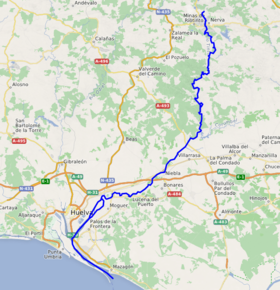Rio Tinto (river) facts for kids
Quick facts for kids Río Tinto |
|
|---|---|

Rio Tinto
|
|

Course of the Rio Tinto
|
|
| Other name(s) | Tinto River |
| Country | Spain |
| Region | Andalusia |
| Physical characteristics | |
| Main source | Sierra Morena Andalusia |
| River mouth | Gulf of Cádiz 37°12′36″N 6°56′17″W / 37.21°N 6.938°W |
| Length | 100 km (62 mi) |
The Río Tinto (Spanish pronunciation: [ˈri.o ˈtinto], red river or Tinto River) is a river in southwestern Spain that rises in the Sierra Morena mountains of Andalusia. It flows generally south-southwest, reaching the Gulf of Cádiz at Huelva. The Rio Tinto river has a unique red and orange colour derived from its chemical makeup that is extremely acidic and with very high levels of iron and heavy metals.
The river maintains its colour for an approximate length of 50 kilometres. After the 50 kilometre mark, the chemistry that makes the Rio Tinto river so unique appears to slowly decline, as does the odd colouring. The location where the chemistry of the river is altered is near a town called Niebla. The river's chemistry begins to significantly change following the town of Niebla owing to the fact that the Rio Tinto blends itself with other streams that are connected to the Atlantic Ocean. The river is approximately 100 km (62 mi) long and is located within the Iberian Pyrite Belt. This area has large amounts of ore and sulfide deposits.
The Rio Tinto area has been the site of approximately 5,000 years of ore mining, including copper, silver, gold, and other minerals, extracted as far as 20 kilometres from the river shores. As a possible result of the mining, the Río Tinto is notable for being very acidic (pH 2) and its deep reddish hue is due to iron dissolved in the water. Acid mine drainage from the mines leads to severe environmental problems because the acidity (low pH) dissolves heavy metals into the water. It is not clear how much acid drainage has come from natural processes and how much has come from mining. There are severe environmental concerns over the pollution in the river.
Although the river represents a harsh environment for life, some microorganisms classified as extremophiles do thrive in these conditions. Such life forms include certain species of bacteria, algae and heterotrophs.
History
The ore body was deposited during the Carboniferous period (300–350 Ma) by hydrothermal activities on the sea floor. The history of mining in the Rio Tinto area traces back to the Tartessans and the Iberians starting mining in 3000 BC, followed by the Phoenicians, Greeks, Romans, Visigoths, and Moors. The Rio Tinto region has been the source of approximately 5,000 years of ore extraction, and chemical refinement primarily for copper, silver and gold, and later for iron, manganese and other minerals. This long standing mining activity has vastly modified the topography of the region.
After a period of abandonment and disuse, the mines were rediscovered in 1556 and the Spanish government began operating them once again in 1724. In the 19th century, companies from the United Kingdom started large-scale mining operations. In 1873, the Rio Tinto Company was formed to operate the mines. Production declined after the peak of production in 1930, and it ended in 1986 for copper mining and in 1996 for silver and gold mining. All mining ended in 2001.
Increased copper prices in the 2010s led to efforts by EMED Mining to reopen the mine, but difficulties in acquiring all necessary property rights, environmental concerns, and obtaining regulatory approval delayed reopening. The mine, which employed as many as 20,000 in the past, would employ 350 people during its startup phase. Environmental concerns are centered on long disused water reservoirs which might not be able to withstand the stress of renewed waste inputs.
Astrobiology
This river has gained recent scientific interest due to the presence of extremophile anaerobic bacteria that dwell in the acidic water. The subsurface rocks on the river bed contain iron and sulfide minerals on which the bacteria feed. The extreme conditions in the river may be analogous to other locations in the Solar System thought to contain liquid water, such as groundwater on Mars. Scientists have also directly compared the chemistry of the water in which the Mars rocks of Meridiani Planum were deposited in the past with the Río Tinto. Likewise, the moon Europa contains an acidic ocean of water underneath its ice surface, thus the Rio Tinto river is of interest to astrobiologists studying the environmental limits of life and planetary habitability.
See also
 In Spanish: Río Tinto para niños
In Spanish: Río Tinto para niños
- Acid mine drainage
- Environmental effects of mining
- List of rivers of Spain
- Tourist Mining Train


